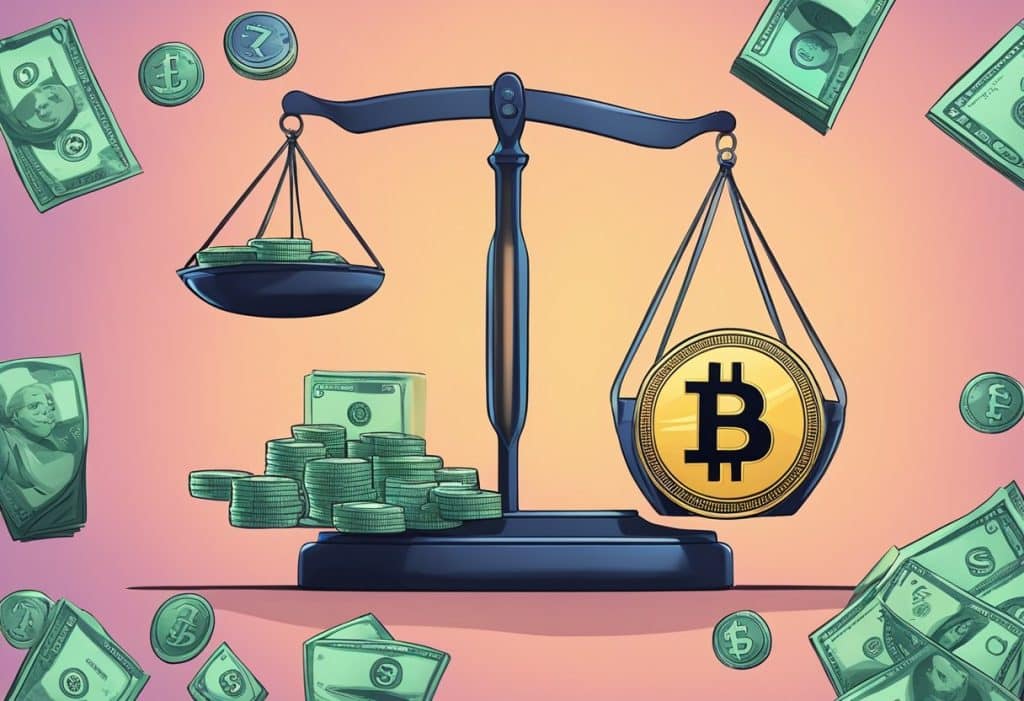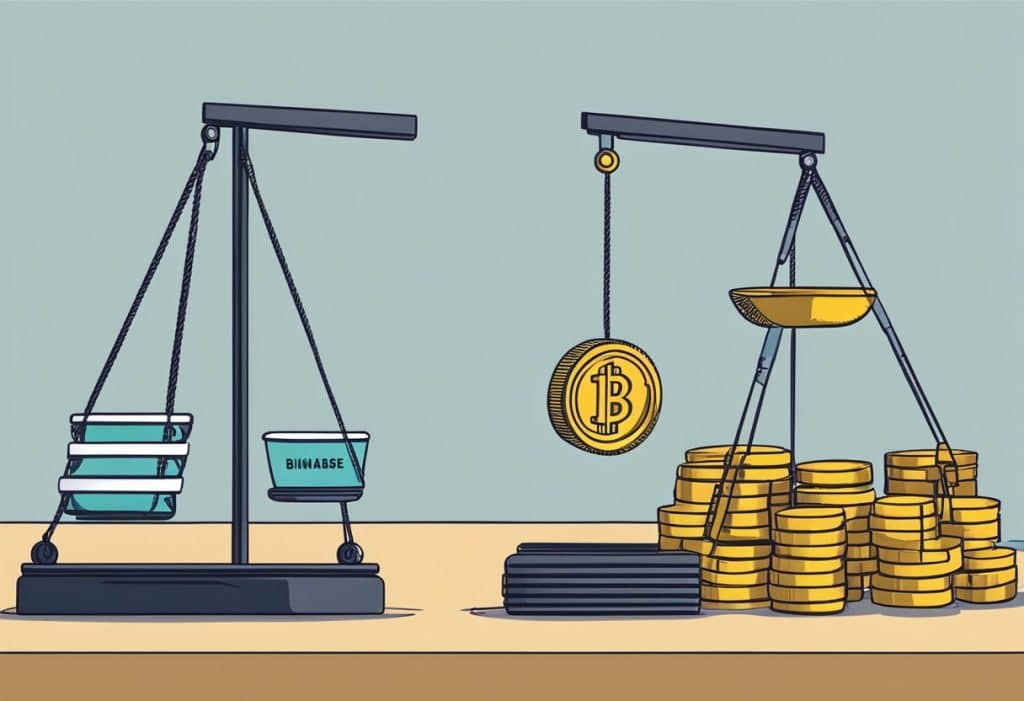When choosing a cryptocurrency exchange, two names often come to the forefront: Binance and Coinbase. Both platforms offer a range of services for various types of traders, whether you’re a novice looking for simplicity and ease of use or a seasoned trader searching for an exchange with a wide array of tools and low fees. Keep reading to know who comes out on top in the Binance vs. Coinbase matchup!
Binance is known for its extensive list of supported cryptocurrencies and competitive fees, making it a go-to for users seeking a cost-effective trading experience. Meanwhile, Coinbase is recognized for its user-friendly interface and strong regulatory standing, providing peace of mind for those new to crypto trading or who prioritize compliance and security.
Key Takeaways
- Binance and Coinbase are two leading exchanges with distinct advantages for different trader profiles.
- Coinbase prioritizes user-friendliness and regulatory compliance, while Binance stands out for its low fees and broad cryptocurrency support.
- Both offer unique features, but you must consider factors like security, fee structure, and available tools when choosing the right exchange for your needs.
NOT YET A BINANCE USER?
Join today with the Binance Referral Code for exclusive benefits or read our Binance Review to learn why Binance is the right exchange for you!
GET UP TO 50% OFF TRADING FEES WITH THE CODE “WUPBLUYN”
Binance vs. Coinbase Overview
In your exploration of cryptocurrency exchanges, you’ll find that Binance and Coinbase stand out with their distinct features and storied pasts. These platforms provide you with a gateway to the world of digital currencies, each with a set of tools tailored to both beginners and experienced traders.
Key Features and Services
Binance offers an extensive range of services, including:
- Spot trading with low fees of about 0.1% for most trades.
- Access to a wide array of over 350 cryptocurrencies.
- A diverse selection of fiat currencies, with support for more than 60.
- The Binance Academy, an educational resource to enhance your trading knowledge.
- Trust Wallet, a third-party wallet service for cryptocurrency storage.
On the other hand, Coinbase provides features such as:
- A user-friendly interface ideal for those new to cryptocurrency.
- Coinbase Pro, a platform with advanced trading options and charting tools.
- Competitive trading fees, with transactions on Coinbase Advanced ranging up to 0.60%.
- Interest accrual on certain cryptocurrencies if you engage in staking.
- Staking options with up to 5.75% APY on certain cryptocurrencies.
Binance and Coinbase: A Brief History
Binance was established in 2017 by Changpeng Zhao (often referred to as CZ) and quickly rose to prominence as one of the largest international cryptocurrency exchanges in terms of trading volume. Its rapid growth can be attributed to its vast selection of trading pairs and its international approach to the market.
Coinbase, founded in 2012 by Brian Armstrong, holds a pivotal role in the cryptocurrency exchange sector, especially for users in the United States. It is known for its stringent adherence to regulatory compliance and its straightforward approach to buying and selling cryptocurrencies.
Both platforms emphasize security, customer support, and continuous development to meet your evolving needs in the dynamic environment of cryptocurrency trading. Their ongoing updates and feature additions are geared towards providing you with a comprehensive trading and investing experience.
Available Cryptocurrencies

When you’re selecting a cryptocurrency exchange, the variety and type of available cryptocurrencies are crucial factors. Both Binance and Coinbase offer a spectrum of cryptos, including popular and lesser-known altcoins.
Diversity of Offerings
Binance has a reputation for offering a broader array of cryptocurrencies. They provide access to over 600 cryptocurrencies for global traders and around 150 for U.S. investors on Binance.US. This includes major cryptocurrencies like Bitcoin (BTC) and Ethereum (ETH), as well as an extensive variety of altcoins. Binance is also the creator of Binance Coin (BNB), which is an integral part of its ecosystem.
Coinbase, on the other hand, supports over 200 cryptocurrencies. While it might have fewer options compared to Binance, it includes most of the mainstream cryptos and a selection of niche altcoins. As a U.S.-based exchange, Coinbase ensures that each cryptocurrency they support adheres to local regulations, which might explain the more curated selection.
| Exchange | Major Cryptocurrencies | Altcoins | Own Cryptocurrency |
|---|---|---|---|
| Binance | BTC, ETH, and more | Yes, extensive | Binance Coin (BNB) |
| Coinbase | BTC, ETH, and more | Yes, selective | None |
Remember that while diversity is important, so too is the exchange’s compliance with regulations, which can affect the availability of certain cryptocurrencies in different regions.
Trading Options and Tools
When you’re evaluating Binance and Coinbase, your trading needs determine which platform serves you best. Each offers a different suite of options and tools designed for various levels of trading experience, from beginner to advanced.
Futures, Margin, and Options Trading
Binance boasts a broad range of trading options for the more experienced trader. This includes:
- Futures trading with high leverage options.
- Margin trading, allowing you to borrow funds to increase your trading position.
- Various order types, including limit, market, and stop-limit orders, to complement different trading strategies.
Coinbase, while catering more to beginners and intermediate users, also offers:
- Margin trading for eligible users, though it’s more limited compared to Binance.
- Limited options trading through Coinbase Pro.
Advanced Charting and Analysis
For advanced charting:
- Binance provides an extensive set of tools for technical analysis. Traders can customize charts, apply various technical indicators, and use drawing tools to analyze price movements and trends.
- Coinbase also offers advanced charting through Coinbase Pro, allowing you to analyze crypto markets using a suite of charting and graphing tools.
In terms of trading tools:
- Binance offers advanced users a combination of tools and features to develop a sophisticated trading strategy, including API access for automated trading.
- Coinbase has user-friendly trading tools which are more aligned with individuals who prefer an intuitive and straightforward platform.
Each platform’s tools and options are tailored to suit your level of expertise and trading needs. Whether your priority is an array of advanced order types or user-friendly chart analysis, both Binance and Coinbase have something to offer.
Fee Structures and Costs

When you’re choosing between Binance and Coinbase, understanding their fee structures for trading, deposits, and withdrawals is crucial for making an informed decision.
Comparison of Trading Fees
Binance offers a competitive trading fee structure with a 0.1% spot-trading fee. For high-volume traders, this fee can decrease inversely with the size of the order. Moreover, Binance utilizes a maker-taker model with maker fees at 0.4% and taker fees at 0.6%, incentivizing users who add liquidity to the market.
Coinbase, on the other hand, has a more complex fee structure. Besides trading fees, a commission may be charged. The precise fee you’ll incur depends on multiple variables, such as the payment method used, with fees ranging as high as 5.0% for certain transactions.
Withdrawal and Deposit Fees
For withdrawals and deposits, both Binance and Coinbase may charge fees, which can vary widely depending on the type of transaction and the currency involved. On Coinbase, there’s a $10 minimum investment requirement, and the platform may offer incentives like $5 in bitcoin for verifying new accounts. Binance sets a minimum at a slightly lower threshold of $10.
When you fund your account or withdraw funds, it’s important to note that both platforms may impose fees that are not directly tied to trading commissions but are rather related to the transfer of funds. Always check the specific fee schedule on the respective exchange to understand the exact costs for your transactions.
By paying attention to these details when comparing Binance and Coinbase, you can select the platform that aligns best with your trading habits and financial goals.
Security and Safety

When considering Binance and Coinbase, your security is paramount. Both platforms employ rigorous security measures to protect your funds, including two-factor authentication and the majority of assets held in cold storage.
Protection Measures and Insurance Funds
Binance:
- Two-Factor Authentication (2FA): You can secure your Binance account with an additional layer of security using 2FA.
- Cold Storage: A large proportion of your assets on Binance are stored offline, which protects them from unauthorized access.
- Secure Asset Fund for Users (SAFU): In the event of a security breach, Binance has a SAFU fund to cover potential losses.
Coinbase:
- Two-Factor Authentication (2FA): Your Coinbase account protection includes mandatory 2FA, offering robust security.
- Cold Storage: Coinbase also maintains the major part of digital assets in cold storage, mitigating risk from online threats.
- Insurance: Your USD balances in Coinbase are covered by FDIC insurance, offering additional peace of mind.
Both Binance and Coinbase invest in comprehensive security systems to secure your investments against cyber threats and ensure a safe trading environment for you.
User Experience

Your journey through cryptocurrency trading platforms hinges on their user experience. You prioritize ease of use and a clear, intuitive interface especially if you’re just beginning in the crypto world.
Platform Interface and Usability
Binance offers a streamlined experience with a user interface that caters to different experience levels. You might find it complex at first, but it provides detailed trading information beneficial for intermediate to advanced users. In contrast, Coinbase is celebrated for its beginner-friendly platform, boasting a simple and intuitive interface that helps you quickly understand the basics of cryptocurrency trading.
Mobile App Availability
Both Binance and Coinbase provide mobile applications for iOS and Android platforms. These apps bring the full experience of cryptocurrency trading to your smartphone, making it convenient for you to trade on the go. The apps maintain the core features of their respective web interfaces, with Binance offering advanced trading tools and Coinbase ensuring a straightforward, beginner-oriented navigation.
Regulation and Compliance

When it comes to choosing a cryptocurrency exchange like Binance or Coinbase, understanding their regulatory stance is crucial. You’ll want to note how these platforms adhere to financial regulations which can affect your trading activities and the security of your funds.
Operating Legality in Different Jurisdictions
Binance and Coinbase operate globally and are subject to a myriad of international financial regulations. Compliance with these regulations is not uniform and varies by jurisdiction.
- United States: Both exchanges have encountered regulatory scrutiny by entities such as the Securities and Exchange Commission (SEC). Binance has faced lawsuits alleging that the leadership was aware of contraventions to U.S. regulations, while Coinbase, as a registered financial institution, actively works to comply with U.S. laws. Among states, New York and Texas have their own specific regulatory requirements, which both exchanges have to navigate carefully. States like Hawaii and Vermont also have unique regulations that can impact their operations.
- United Kingdom (UK): The regulations in the UK may differ from those in the U.S., where both exchanges must comply with the UK Financial Conduct Authority. The implications of these regulations direct the way that these exchanges handle British Pounds (GBP), adhere to anti-money laundering standards, and protect their users.
- European Union (EU): The presence of the Euro brings another layer of regulatory complexity. While the EU works towards a unified digital asset framework, both exchanges must adhere to the laws of individual member states, which can impose their regulations on how cryptocurrencies are treated as potential securities, and how Euros are managed within the exchanges.
It’s imperative for you to stay informed on the regulatory status of Binance and Coinbase, especially in jurisdictions that are relevant to your trading activity. Regulations can have profound effects on the functionality and availability of services offered by these exchanges in different regions.
Support and Resources
When comparing Binance and Coinbase, it’s essential to consider the support and resources each platform offers to enhance your trading experience.
Customer Support
Binance and Coinbase strive to provide you with robust customer support networks.
Binance:
- Contact Methods: Email support, live chat, and a ticketing system.
- Response Time: Known for rapid response, typically within a few hours to a day.
- User-Friendly Help Center: A comprehensive FAQ section that addresses common issues.
Coinbase:
- Contact Methods: Email, phone support, and live chat available for immediate assistance.
- Response Time: Aims to be quick, though some users may experience delays during high traffic periods.
- Dedicated Support Page: Offers a detailed help center with the ability to directly report issues.
Educational Material
Both Binance and Coinbase deliver extensive educational content to help you understand cryptocurrency and improve your trading skills.
Binance Academy:
- Content Variety: Offers articles, videos, tutorials and even glossaries to ensure you have a range of materials at your disposal.
- Level of Detail: From beginner to advanced topics, Binance Academy helps deepen your knowledge.
Coinbase:
- Learning Platform: Provides user-friendly guides, informative blog posts, and news updates.
- Cryptocurrency Rewards: Unique feature where you can earn crypto by learning about different currencies.
Both platforms are competitive when it comes to support and resources, each with a commitment to helping you navigate the complexities of cryptocurrency trading and investment.
Accessibility and Payment Methods

When engaging with crypto exchanges like Binance and Coinbase, you have access to a variety of payment methods to fund your account. Whether you prefer using a debit card or arranging for a bank transfer, these platforms cater to your needs with multiple options for both deposits and withdrawals.
Payment Options for Users
- Binance:
- Debit Card: Accepts debit card payments for buying cryptocurrencies.
- Wire Transfers: Allows users to deposit funds using wire transfers which could take longer to process but are effective for large transactions.
- Bank Transfer: Supports bank transfers as a method to fund your account, often referred to as ACH in the US.
- Crypto Deposits: You can deposit various cryptocurrencies directly into your Binance wallet.
- Coinbase:
- Debit Card: Enables immediate crypto purchases using a debit card.
- Wire Transfers: Offers wire transfers, particularly beneficial for expedited large transactions.
- Bank Transfer: Supports ACH bank transfers for US customers, providing an easy way to link your bank account.
- Crypto Deposits: Also allows direct crypto deposits from external wallets into your Coinbase wallet.
Both platforms provide secure methods to initiate transactions, though you need to remain aware of the potential fees and processing times which vary from one payment method to another. Keep in mind that the availability of these payment options may differ based on your location and the regulations that pertain to it.
Unique Features and Offers
When evaluating Binance and Coinbase, you’ll discover a variety of unique features and offers that cater to different user needs, such as staking rewards, earning potentials, and specialized payment services.
Exclusive Services and Products
Binance provides Binance Pay, a contactless, borderless, and secure cryptocurrency payment technology designed to facilitate transactions for users. You can take advantage of this feature for your purchases, both online and in-store, using cryptocurrencies.
In terms of earning, Binance offers competitive staking options that allow you to earn rewards by holding certain cryptocurrencies. You’ll find the staking yields can be considerably high, leading to potentially greater earning outcomes for your crypto assets. Moreover, the platform’s lending services can diversify ways you earn through your crypto holdings.
Coinbase, on the other hand, extends its feature set with tailored offers such as the Coinbase Rewards program, where you can earn crypto for learning about new digital assets. The platform enables you to earn interest through staking, with interest rates reaching up to 5.75% APY on certain staked cryptocurrencies, offering you an incentive to hold and grow your investments on the platform.
Both platforms aim to make earning on your assets straightforward and accessible. Your choice between Binance and Coinbase may hinge on the specific earning rates, the range of currencies available for staking, and the ease of use of their ancillary services.
Market Presence and Liquidity
In the dynamic realm of cryptocurrency exchanges, your choice between platforms can significantly affect your trading experience. A critical aspect of this choice hinges on market presence and liquidity, which determine an exchange’s ability to fulfill large orders without substantial price changes.
Volume and Liquidity Comparison
Liquidity is influenced by trading volume—the higher the volume, the more liquid a market is. In this regard, Binance boasts a substantial lead with a daily trading volume of approximately $15.82 billion, compared to Coinbase’s $1.78 billion. These numbers not only reflect overall market presence but also impact how quickly and efficiently you can execute trades.
Binance’s higher trading volume suggests that it can generally offer better liquidity, reducing the spread (the difference between the buy and sell price) and potentially leading to better pricing for you as a trader. Conversely, while Coinbase’s trading volume is lower, it still maintains sufficient liquidity to meet the needs of many traders.
Considering market capitalization, neither Binance nor Coinbase directly influence this metric, as it pertains to the cryptocurrencies listed on their platforms. However, their market presence can indirectly affect market capitalization by providing markets where these assets are bought and sold, contributing to price discovery and interest in various cryptocurrencies.
Pros and Cons
In choosing between Binance and Coinbase, you should consider various factors tailored to your needs as an investor or trader. The advantages and disadvantages outlined below will help you make an informed decision on which exchange might better suit your preferences, whether you’re a beginner or an experienced user.
Advantages Over Competitors
- Binance US:
- Lower Fees: You benefit from a trading fee of 0.1% for both market makers and takers.
- Binance Coin (BNB): Holding BNB can offer additional fee discounts.
- High Yield: Staking certain cryptocurrencies may result in higher returns compared to competitors.
- Variety of Cryptocurrencies: Access to a wide range of altcoins.
- Coinbase:
- User-Friendly: Ideal for beginners due to its ease of use.
- Regulatory Compliance: Robust security measures and compliance with SEC regulations can provide you with peace of mind.
- Fiat Currency Support: Supports a variety of fiat currencies for easy transactions.
Drawbacks and Limitations
- Binance US:
- Limited for U.S. Customers: Fewer cryptocurrencies available than the global Binance platform.
- Regulatory Issues: Has faced scrutiny from regulatory bodies, raising concerns about stability.
- Coinbase:
- Higher Fees: You’ll incur fees ranging from 0.5% to 4.5%, significantly more than Binance for standard accounts.
- Staking Interest: Lower APY on staked crypto compared to Binance US.
Frequently Asked Questions
When evaluating Binance and Coinbase, it’s essential to explore specific factors that influence your trading experience. These include transaction fees, cryptocurrency availability, security protocols, accessibility for US traders, user interface complexities, and the overall market presence of each platform.
What factors should be considered when comparing transaction fees between Binance and Coinbase?
When examining transaction fees, consider the maker-taker fees, withdrawal fees, and any additional costs associated with different transaction types. Binance generally offers lower fees compared to Coinbase, with even further reductions for those holding Binance Coin (BNB) or using higher volumes.
How do Binance’s and Coinbase’s supported cryptocurrencies differ?
Coinbase offers a more limited selection of cryptocurrencies focused on the most popular and well-established coins, which suits beginners. Binance, in contrast, supports a more extensive array of over 500 cryptocurrencies, catering to traders interested in a wide variety of altcoins.
In terms of security and trustworthiness, how do Binance and Coinbase compare?
Both platforms have robust security measures, including two-factor authentication and FDIC insurance for USD balances. Binance experienced a significant security breach in 2019 but has since bolstered its security framework. Coinbase is known for its stringent security protocols and is widely regarded as one of the most secure platforms.
Can users from the United States trade on Binance, or is Coinbase the only option?
US-based users cannot trade on the global Binance platform due to regulatory restrictions but can use Binance.US, a separate exchange tailored to comply with US regulations. Coinbase is fully operational in the United States and is often the go-to platform for US traders.
How does the user experience differ between Binance and Coinbase for novice traders?
Coinbase offers a user-friendly interface ideal for beginners, with simple navigation and easy-to-understand trading processes. Binance, while it also has a user-friendly interface, is known for its more advanced trading features and tools that may suit experienced traders better.
What is the market share contrast between Binance and Coinbase, and what does it indicate about their size and influence?
Binance is the largest cryptocurrency exchange globally by trading volume, indicating a substantial market presence and high liquidity. Coinbase is one of the most prominent exchanges in the United States and is recognized for its ease of use and high level of regulatory compliance, making it a substantial player in the market, particularly for retail investors.
